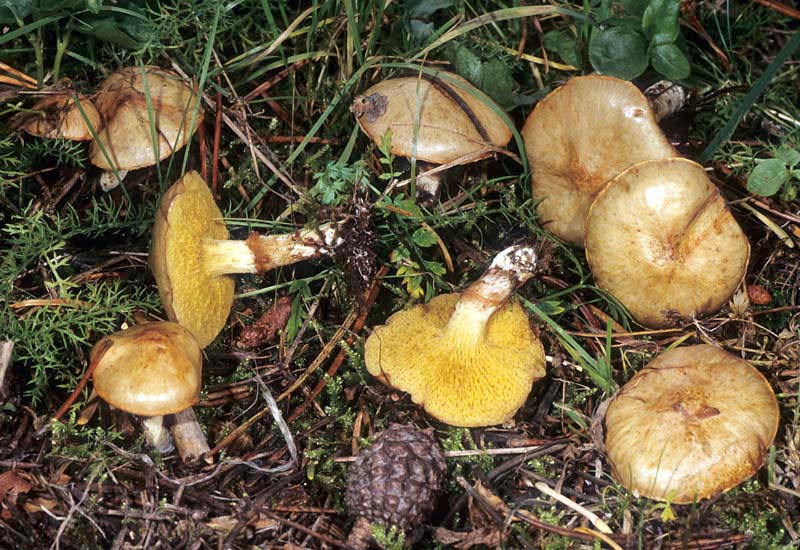Suillus umbonatus
Mycologia 52(3): 446. 1960.
Common Name: none
-
Pileus
Cap 2.0-8.0 cm broad, convex, expanding to plano-convex, sometimes with a low umbo; margin decurved, occasionally wavy in outline, normally not appendiculate; surface more or less glabrous, at times shallowly pitted or with small depressions, viscid when moist, buff to pale olive-grey, often spotted or streaked rusty-brown; context soft, thick, pale, dingy-buff, slightly darker when cut and developing dull vinaceous tones; odor harsh, similar to that of Suillus pungens; taste mild.
-
Hymenophore
Pores radiating from the stipe, dull ochraceous, angular, elongated, up to 2 mm in the longest dimension, not discoloring when bruised; tubes 0.4-1.0 cm long, colored like the pores or darkening somewhat when cut, adnate to subdecurrent at the stipe.
-
Stipe
Stipe 2-5 cm long, 0.5-1.0 cm thick, round, solid, equal to tapering to a narrowed base, sometimes twisted or with a basal bend; surface at the apex ochraceous, longitudinally striate or obscurely reticulate from partially descending tubes, pallid below when young, but in age developing brownish glands or discolorations where bruised; partial veil membranous-viscid, translucent buff-brown, forming a ragged, superior veil, typically appressed to the stipe and colored brown from spores.
-
Spores
Spores 8-10 x 3.5-4 µm, smooth, thin-walled, narrowly elliptical to subfusiform; spore print brownish-olive.
-
Habitat
Solitary to gregarious in conifer woods; believed to be mycorrhizally associated with beach pine (Pinus contorta); relatively common north of San Francisco along the Mendocino coast; fruiting from late fall to mid-winter.
-
Edibility
Probably edible but untried due to a viscid cap and minimal texture.
-
Comments
Suillus umbonatus is among the drabbest, least conspicuous of our local slippery jacks. It is recognized by a viscid, buff to pale olive-grey cap often with reddish-brown streaks, ochraceous tubes that do not discolor, and a viscid brownish annulus. Despite the species name, the presence of an umbonate cap is not a consistent character and may be lacking in some collections.
-
References
Arora, D. (1986). Mushrooms Demystified. Ten Speed Press: Berkeley, CA. 959 p.
Bessette, A.E., Roody, W.C. & Bessette, A.R. (2000). North American Boletes: A Color Guide to the Fleshy Pored Mushrooms. Syracuse University Press: Syracuse, NY. 400 p.
Desjardin, D.E., Wood, M.G. & Stevens, F.A. (2015). California Mushrooms: The Comprehensive Identification Guide. Timber Press: Portland, OR. 560 p.
Dick, E.A. & Snell, W.H. (1960). Notes on Boletes. XIII. Mycologia 52(3): 444-454. (Protologue)
Siegel, N. & Schwarz, C. (2016). Mushrooms of the Redwood Coast. Ten Speed Press: Berkeley, CA. 601 p.
Smith, A.H. & Thiers, H.D. (1964). A Contribution Toward A Monograph of North American Species of Suillus. Privately Published: Ann Arbor, MI. 116 p. (PDF)
Thiers, H.D. (1967). California boletes III. The genus Suillus. Madroño 19: 148-160.
Thiers, H.D. (1975). The status of the genus Suillus in the United States. Beih. Nova Hedw. 51: 247-278.
Thiers, H.D. (1975). California Mushrooms—A Field Guide to the Boletes. Hafner Press: New York, NY. 261 p. (WWW)
Thiers, H.D. (1979). The genus Suillus in the Western United States. Mycotaxon 9(1): 285-296. (PDF) -
Other Descriptions and Photos
- Michael Wood: Suillus umbonatus (CP)

- Michael Wood: Suillus umbonatus (CP)

- Michael Wood: Suillus umbonatus (CP)

- Michael Wood: Suillus umbonatus (CP) — young sporocarp showing slime veil
- Fred Stevens: Suillus umbonatus (CP)

- Boletes of California: Suillus umbonatus (D & CP)
- Mushroom Observer: Suillus umbonatus (CP)
- Mushroom Hobby: Suillus umbonatus (CP)
- Rogers Mushrooms: Suillus umbonatus (D & CP)
- Arora (1986): p. 498 (D & P)
- Arora (1991): p. 179 (D & CP)
- Bessette et al. (2000): p. 235 (D), p. 334 (CP) [as Suillus flavidus]
- Miller: sp. 286 (D)
- Orr & Orr: p. 97 (D)
- Phillips: p. 248 (D), p. 249 (CP)
- Tylutki (1987): p. 50 (D), p. 51 (P)
- Michael Wood: Suillus umbonatus (CP)
